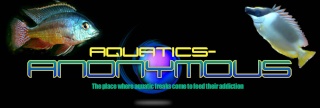[You must be registered and logged in to see this image.]
Daffodil Cichlid/Neolamprologus Pulcher
The Daffodil Cichlid is both elegant and gracious. Not only is it very attractive, but it is hardy, making it ideal for any aquariust to keep. It is moderately easy to care for as long it has the proper sized aquarium and the right tank mates. It will eat a wide variety of aquarium foods and is not shy about swimming out in the open.
These are a schooling fish that pair off only to breed. The Daffodil Cichlid can be kept in a species tank, or a group of these fish can be kept with other durable species in a good sized aquarium. They may scrap a bit with each other (which keeps them quite busy!) but then they are not inclined to quarrel with others. They like an aquarium with lots of rock formations and caves for retreating. Plants are not essential though they do not harm them, nor do they burrow.
Though the Daffodil Cichlids spend a good deal of their time spawning, they are a secretive shelter spawner. You may not even know they have spawned until you see small fry darting about. A pair of Daffodil Cichlids will spawn again and again. The older fry will help protect the younger ones, thus various ages of fry will be present in the same tank. This is an example of "stepped breeding".
They Daffodil Cichlids are omnivorous and will generally eat all kinds of live, fresh, and flake foods. In the wild they will feed on swarms of plankton drifting in the lake water along with microorganisms such as small crustaceans and invertebrates.To keep a good balance give them a high quality flake food or pellet everyday. Regularly supplement these foods with brine shrimp (either live or frozen) or daphnia. Feed 2 to 5 small pinches of food a day in smaller amounts instead of a large quantity once a day. This will keep the water quality higher over a longer time. A one-day-a-week 'fast' can also be beneficial. Of course, all fish benefit from added vitamins and supplements to their foods.
For a species only tank, a minimum of 15 gallons (though 20 or 35 gallons is better) is suggested. A larger tank, 50 gallons or more, would be required if mixing with other species. They need good water movement along with very strong and efficient filtration. Provide a sandy to very small sized substrate, and they need a lot of rocks and cave formations. Plants are not essential though they do not harm them, nor do they burrow. Subdued lighting is also preferred.
Hardness: 10-20 dGH
Ph: 8.0 to 8.5, wild caught specimens prefer the higher Ph.
Temp: 72-77 ° F (22-25 ° C)
Size: 4-5 inches
Tank Size: 15 gallons+
Daffodil Cichlid/Neolamprologus Pulcher
The Daffodil Cichlid is both elegant and gracious. Not only is it very attractive, but it is hardy, making it ideal for any aquariust to keep. It is moderately easy to care for as long it has the proper sized aquarium and the right tank mates. It will eat a wide variety of aquarium foods and is not shy about swimming out in the open.
These are a schooling fish that pair off only to breed. The Daffodil Cichlid can be kept in a species tank, or a group of these fish can be kept with other durable species in a good sized aquarium. They may scrap a bit with each other (which keeps them quite busy!) but then they are not inclined to quarrel with others. They like an aquarium with lots of rock formations and caves for retreating. Plants are not essential though they do not harm them, nor do they burrow.
Though the Daffodil Cichlids spend a good deal of their time spawning, they are a secretive shelter spawner. You may not even know they have spawned until you see small fry darting about. A pair of Daffodil Cichlids will spawn again and again. The older fry will help protect the younger ones, thus various ages of fry will be present in the same tank. This is an example of "stepped breeding".
They Daffodil Cichlids are omnivorous and will generally eat all kinds of live, fresh, and flake foods. In the wild they will feed on swarms of plankton drifting in the lake water along with microorganisms such as small crustaceans and invertebrates.To keep a good balance give them a high quality flake food or pellet everyday. Regularly supplement these foods with brine shrimp (either live or frozen) or daphnia. Feed 2 to 5 small pinches of food a day in smaller amounts instead of a large quantity once a day. This will keep the water quality higher over a longer time. A one-day-a-week 'fast' can also be beneficial. Of course, all fish benefit from added vitamins and supplements to their foods.
For a species only tank, a minimum of 15 gallons (though 20 or 35 gallons is better) is suggested. A larger tank, 50 gallons or more, would be required if mixing with other species. They need good water movement along with very strong and efficient filtration. Provide a sandy to very small sized substrate, and they need a lot of rocks and cave formations. Plants are not essential though they do not harm them, nor do they burrow. Subdued lighting is also preferred.
Hardness: 10-20 dGH
Ph: 8.0 to 8.5, wild caught specimens prefer the higher Ph.
Temp: 72-77 ° F (22-25 ° C)
Size: 4-5 inches
Tank Size: 15 gallons+



